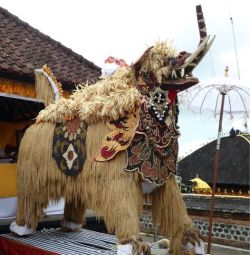- a kind of an offering en

This is called salaran and takes the form of an animal, in this example a gajah or asti, an elephant. The idea is to create fauna from flora, reflecting the duality of rwa bhineda. They are usually paired with huge sate tegeh constructions of flora created from fauna or pork skewers.
A salaran must have edible roots, grains, and tree fruits to represent fertility of the 3 realms of lower, middle, and upper realms. The toes of this elephant are tubers, hair of rice on the stalks, seed covered ornaments, back and tail of corn with husks. The positions of these edibles reflect where they grow. One cannot put tubers in a high place on the head since they grow underground.
Originally made in the Selat-Duda area of Karangasem in the village of Griyana Kauh, they have become popular almost everywhere on the island due to motorcycles and cars and phone cameras, but only for very big temple ceremonies.
Unless you go to such big events, you will not see salaran. They appear annually at Besakih during the temple festival there in March-April and usually in their original form with whole edible products tied to a bamboo frame shaped like an animal and not as detailed, such as corn on cob for teeth and whole husked coconuts for eyes. The hair is always made of stalks of rice.A salaran must have edible roots, grains, and tree fruits to represent fertility of the 3 realms of lower, middle, and upper realms. The toes of this elephant are tubers, hair of rice on the stalks, seed covered ornaments, back and tail of corn with husks. The positions of these edibles reflect where they grow. One cannot put tubers in a high place on the head since they grow underground.
Originally made in the Selat-Duda area of Karangasem in the village of Griyana Kauh, they have become popular almost everywhere on the island due to motorcycles and cars and phone cameras, but only for very big temple ceremonies.
Unless you go to such big events, you will not see salaran. They appear annually at Besakih during the temple festival there in March-April and usually in their original form with whole edible products tied to a bamboo frame shaped like an animal and not as detailed, such as corn on cob for teeth and whole husked coconuts for eyes. The hair is always made of stalks of rice.




